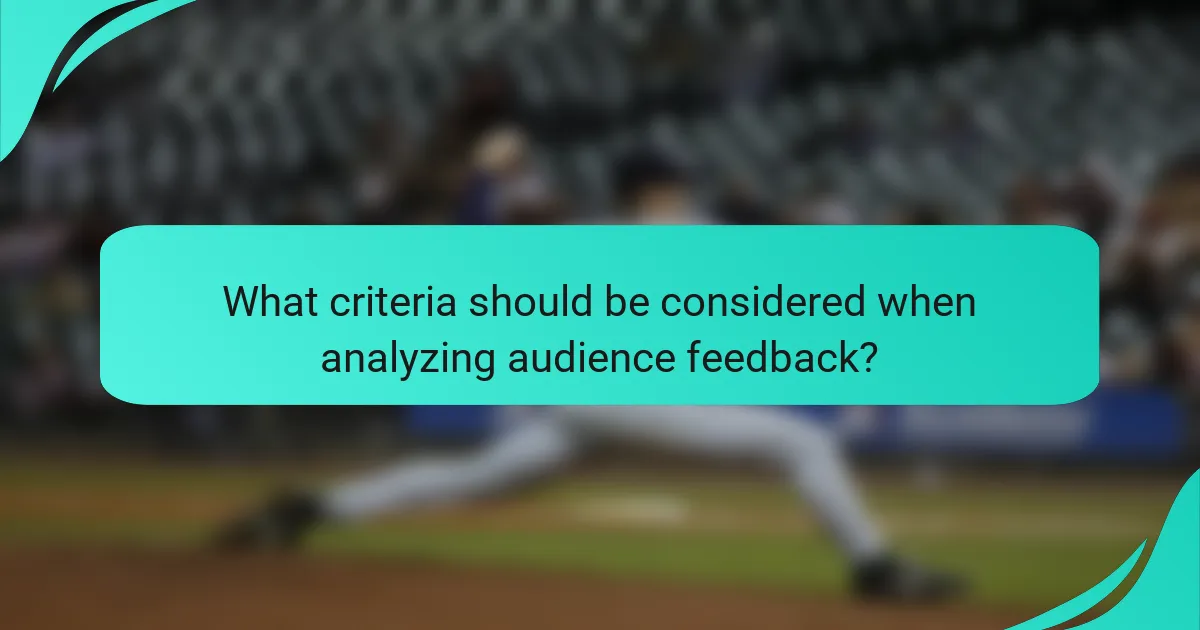Audience feedback plays a crucial role in shaping content strategies by offering valuable insights into viewer preferences and engagement. By leveraging real-time data and social media sentiment analysis, creators can adapt their content to align with audience expectations, ultimately fostering greater satisfaction and loyalty.

How does audience feedback influence content strategy?
Audience feedback directly shapes content strategy by providing insights into what resonates with viewers. This information allows creators to tailor their content to meet audience preferences, ultimately enhancing engagement and satisfaction.
Increased engagement metrics
Incorporating audience feedback can lead to higher engagement metrics, such as likes, shares, and comments. By analyzing which topics or formats generate the most interaction, content creators can focus on producing similar content that captures attention.
For example, if feedback indicates a preference for video content over written articles, shifting resources to create more videos can significantly boost engagement rates. Regularly monitoring these metrics helps in adjusting strategies effectively.
Improved audience retention
Audience feedback plays a crucial role in improving retention rates by identifying what keeps viewers coming back. Understanding preferences allows for the creation of content that aligns with audience interests, reducing churn.
For instance, if surveys reveal that audiences enjoy in-depth tutorials, consistently delivering this type of content can enhance viewer loyalty. Strategies like personalized recommendations based on feedback can further support retention efforts.
Enhanced brand loyalty
When audiences feel their feedback is valued, it fosters a sense of loyalty towards the brand. Engaging with feedback shows that a brand listens and adapts, which can strengthen the emotional connection with its audience.
Brands can enhance loyalty by implementing feedback-driven changes and communicating these adjustments to their audience. For example, if a brand introduces new features based on user suggestions, promoting these changes can reinforce trust and commitment among followers.

What are the current trends in audience feedback?
Current trends in audience feedback emphasize the importance of real-time data collection, social media sentiment analysis, and personalized content experiences. These approaches allow creators and marketers to adapt their strategies quickly and effectively based on audience preferences and reactions.
Real-time feedback mechanisms
Real-time feedback mechanisms enable organizations to gather audience insights instantly through various tools like polls, surveys, and live chat. This immediate data helps in understanding audience reactions as they happen, allowing for swift adjustments to content or strategy.
For example, using live polls during webinars can provide instant feedback on audience engagement, helping presenters to modify their delivery or content on the fly. Implementing these mechanisms can significantly enhance user satisfaction and retention.
Social media sentiment analysis
Social media sentiment analysis involves monitoring and interpreting audience reactions across platforms like Twitter, Facebook, and Instagram. By analyzing comments, likes, and shares, brands can gauge public sentiment towards their content or products.
Tools such as Hootsuite or Brandwatch can automate this process, providing insights into how audiences feel about specific topics or campaigns. Understanding sentiment can guide content creation and marketing strategies, ensuring alignment with audience expectations.
Personalized content experiences
Personalized content experiences tailor offerings based on individual audience preferences and behaviors. This approach enhances engagement by delivering relevant content to users, increasing the likelihood of interaction and conversion.
Techniques such as using cookies for tracking user behavior or employing recommendation algorithms can help in curating personalized experiences. For instance, streaming services like Netflix utilize viewer history to suggest shows, significantly improving user satisfaction and retention rates.

How can businesses adapt content based on audience feedback?
Businesses can adapt content based on audience feedback by actively listening to their audience’s preferences and behaviors, then making informed changes. This process involves analyzing data, testing variations, and developing detailed audience profiles to ensure content resonates effectively.
Utilizing analytics tools
Analytics tools provide insights into audience behavior, engagement, and preferences. By tracking metrics such as page views, bounce rates, and time spent on content, businesses can identify what resonates with their audience and what does not.
Common tools include Google Analytics, which offers comprehensive data on user interactions, and social media analytics platforms that reveal engagement trends. Regularly reviewing these metrics helps businesses refine their content strategy based on real-time feedback.
Implementing A/B testing
A/B testing allows businesses to compare two versions of content to determine which performs better. By changing one element at a time—such as headlines, images, or calls to action—companies can gather data on audience preferences and optimize their content accordingly.
For effective A/B testing, ensure that the sample size is large enough to yield statistically significant results. Aim for a testing period of at least one to two weeks to account for variations in audience behavior.
Creating audience personas
Audience personas are fictional representations of key segments of a business’s audience, based on data and research. These personas help tailor content to meet the specific needs and preferences of different audience groups.
To create effective personas, gather demographic data, conduct surveys, and analyze customer feedback. Include details such as age, interests, and pain points to ensure content is relevant and engaging for each persona.

What tools are effective for gathering audience feedback?
Effective tools for gathering audience feedback include online survey platforms, analytics software, and social media management tools. These resources help you understand audience preferences, behaviors, and sentiments, enabling content adaptation to better meet their needs.
SurveyMonkey for surveys
SurveyMonkey is a popular tool for creating and distributing surveys to gather audience feedback. It offers customizable templates and a user-friendly interface, allowing you to design surveys that target specific demographics or interests.
When using SurveyMonkey, consider the length and clarity of your questions to maximize response rates. Aim for surveys that take no longer than 5-10 minutes to complete, as shorter surveys typically yield higher engagement.
Google Analytics for behavior tracking
Google Analytics provides insights into user behavior on your website, helping you understand how visitors interact with your content. By analyzing metrics such as page views, bounce rates, and session duration, you can identify which content resonates most with your audience.
To effectively use Google Analytics, set up goals and conversion tracking to measure specific actions, such as newsletter sign-ups or product purchases. Regularly review your data to spot trends and adjust your content strategy accordingly.
Hootsuite for social listening
Hootsuite is a social media management tool that enables you to monitor audience conversations and sentiments across various platforms. By tracking mentions, comments, and hashtags, you can gain valuable insights into how your audience perceives your brand and content.
Utilize Hootsuite’s analytics features to identify popular topics and engagement patterns. This information can guide your content creation and help you address audience concerns or interests more effectively.

What criteria should be considered when analyzing audience feedback?
When analyzing audience feedback, it’s essential to consider criteria such as feedback volume and quality, demographic insights, and engagement trends over time. These factors help in understanding audience preferences and tailoring content effectively.
Feedback volume and quality
Feedback volume refers to the amount of feedback received, while quality assesses the depth and relevance of that feedback. A high volume of feedback can indicate strong audience interest, but it’s crucial to evaluate whether the feedback is constructive or merely emotional responses.
To gauge quality, look for specific comments that provide actionable insights rather than vague statements. For instance, instead of just saying “I didn’t like it,” a more valuable comment would be “The pacing was too slow in the second half.” This type of feedback is more useful for making improvements.
Demographic insights
Understanding the demographics of your audience is vital for tailoring content to meet their needs. Factors such as age, gender, location, and interests can significantly influence how feedback is given and interpreted.
For example, younger audiences may prefer more interactive content, while older demographics might appreciate detailed articles. Analyzing feedback in the context of these demographic insights allows for more targeted content strategies that resonate with specific groups.
Engagement trends over time
Tracking engagement trends over time helps identify shifts in audience preferences and behaviors. Regularly monitoring metrics such as likes, shares, and comments can reveal patterns that inform content adaptation.
For instance, if feedback indicates a growing interest in video content over written articles, it may be time to pivot your strategy. Establish a routine for reviewing engagement data, such as monthly or quarterly, to stay aligned with audience expectations.

What are the challenges in adapting content to audience feedback?
Adapting content to audience feedback presents several challenges, including managing excessive data, catering to varied audience preferences, and allocating resources effectively. Each of these factors can complicate the process of making timely and relevant content adjustments.
Data overload
Data overload occurs when the volume of feedback becomes unmanageable, making it difficult to identify actionable insights. Content creators may receive feedback from multiple channels, such as social media, surveys, and direct comments, leading to conflicting opinions and noise.
To tackle data overload, prioritize feedback based on relevance and frequency. Focus on the most common themes and suggestions rather than trying to address every single piece of feedback. Tools like sentiment analysis can help distill large amounts of data into key trends.
Balancing diverse audience needs
Different segments of an audience often have varying preferences, making it challenging to create content that satisfies everyone. For instance, a tech blog’s readers may range from beginners to experts, each requiring different levels of detail and complexity.
To balance these diverse needs, consider segmenting your audience and tailoring content accordingly. Use targeted messaging or create separate content streams for different audience groups, ensuring that each segment feels valued and heard.
Resource allocation for changes
Adapting content based on feedback often requires significant resources, including time, personnel, and budget. Small teams may struggle to implement changes quickly, especially when juggling multiple projects simultaneously.
To optimize resource allocation, establish a clear process for evaluating feedback and prioritizing changes. Set realistic timelines and consider using project management tools to streamline workflows. Additionally, training team members to handle feedback efficiently can enhance overall responsiveness.
